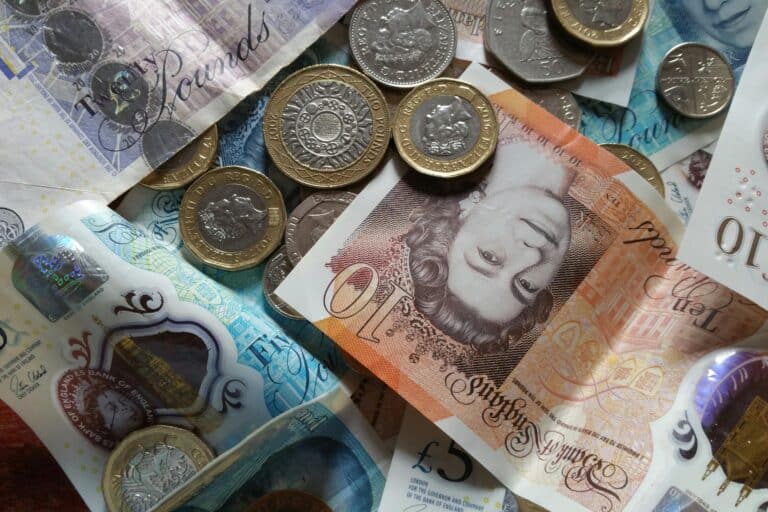How often do you check your change? For most of us, loose coins just get dropped into a pocket, purse, or jar without much thought. But what if that 50p coin you’re carrying is worth hundreds, or even thousands, of pounds?
Some rare 50p coins have become highly collectible. Limited vintages, special commemorative releases, and even minting errors can turn an ordinary-looking coin into a hidden treasure. Some have sold for eye-watering amounts at auction.
With Remitly, every penny counts, whether you’re sending money overseas or spotting a hidden gem in your pocket. In this guide, we’ll explain how to identify rare 50p coins, what makes them so valuable, and how to check if you’ve been carrying one around without realising it.
What makes a 50p coin rare and valuable?
While most 50p coins are worth exactly their face value, some can be worth a lot more. What makes a coin valuable comes down to condition, rarity, and demand. Here are the main things to look out for:
1. Low mintage numbers
Some 50p designs were only made in very limited quantities. Fewer coins in circulation means they’re much harder to find, and more valuable to collectors.
2. Minting errors
Mistakes happen during production. Coins with misprints, off-centre strikes, or unusual metal combinations are often highly sought after. Collectors are often willing to pay more for these coins because errors are unpredictable and unique.
3. Commemorative releases
The Royal Mint regularly issues coins to celebrate national events. From King Charles III’s coronation in 2023 to the Olympic Games, limited editions make these coins highly desirable. Popular themes drive demand even if the mintage isn’t low. If you’re curious about the longer history of money itself, check out our guide to the world’s oldest currencies.
4. Condition
Coins in uncirculated or “mint condition” are usually the most valuable. This means they show little to no signs of wear and have never been in everyday use. The term mint condition actually comes from the world of coin collecting itself.
5. Public demand
Even coins produced in larger quantities can become valuable if collectors love them. Designs featuring popular themes like storybook characters, historical events, or sports often generate enthusiasm and drive the price higher.
Behind all this, the Royal Mint decides which coins enter circulation and in what quantities. Their Advisory Committee, made up of experts in art, heraldry, typography, and sculpture, helps choose new designs. Some of these designs later become rare British coins.
The most valuable 50p coins in circulation
Some 50p coins have become highly sought-after collectibles, and knowing which ones to look out for can make a big difference when you’re checking your change or coin collection. Here are some of the most valuable ones:
Kew Gardens 50p (2009)
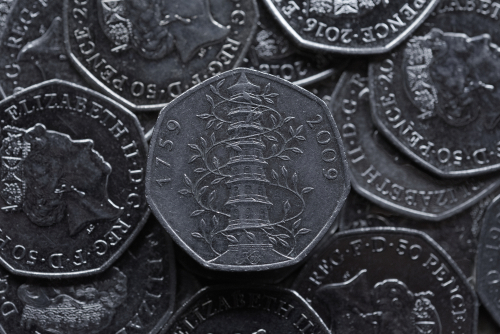
The Kew Gardens 50p is one of the rarest and most desirable 50p coins in circulation. Just 210,000 coins were made, and many were never released into circulation.
For context, that’s seven times fewer than the next rarest 50p coin, the 2018 Peter Rabbit edition. The reverse design of the coin shows the famous Chinese Pagoda in London’s Kew Gardens, with a leafy vine climbing the tower. Although the Royal Mint issued a new version in 2019 for the 10th anniversary, collectors prize the original 2009 release.
As with all coins, the price depends a lot on the condition of the coin. In July 2025, one of these coins sold on eBay for £120.
This coin is rare and valuable enough that criminals have even made fake versions. Here are some things to look for to tell the real from the fake:
- Fakes often have a frosted finish on the pagoda and on the years stamped on the coin.
- The roof of the pagoda is usually too pointy.
- Designer’s initials are usually larger on fakes.
- Queen Elizabeth II’s portrait is more rounded on genuine coins.
- The coin is slightly lighter than a standard 50p.
Olympic Games collection (2011-2012)
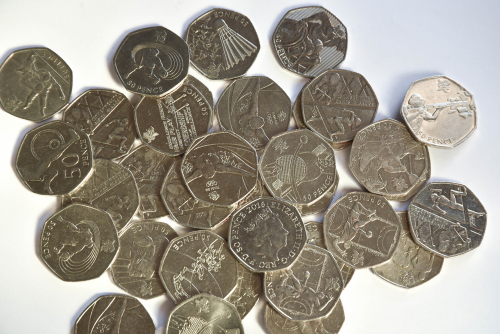
To commemorate the 2012 London Olympics, the Royal Mint released 29 different 50p designs, each depicting a sport such as aquatics, archery, fencing, football, wheelchair rugby, and taekwondo.
These coins were minted in the millions, but the rarest include:
- Football: 1.125 million minted
- Judo: 1.16 million minted
- Wrestling: 1.129 million minted
The Football coin, with a playful design explaining the offside rule, is perhaps the most valuable of the set, with prices reaching around £16. However, this coin has sold for £75 in the past.
Collectors who own the 29-coin complete set can currently expect around £100 for the full collection.
Beatrix Potter Collection (2016-2017)
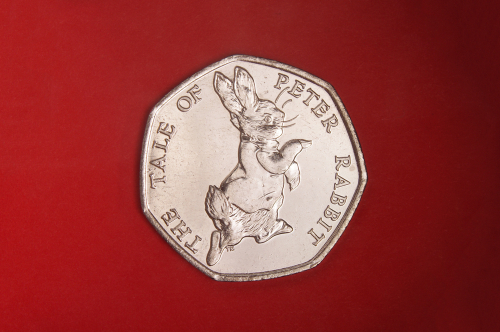
Beatrix Potter’s beloved characters have inspired a collection of 50p coins that remain popular among collectors.
The rarest among them are the Jemima Puddle-Duck version, with 2.1 million minted, and Squirrel Nutkin, with 5 million minted.
The Peter Rabbit 50p has several editions. The 2018 limited run of 1.4 million coins is extremely rare, whereas earlier Peter Rabbit coins had mintages of around 20 million, an example of why checking the details of any coin is key.
Current values:
- Jemima Puddle-Duck is the most valuable, estimated at £10 to £20 for coins in circulation. Coloured versions of these coins were also minted and are worth much more.
- The 2016 Peter Rabbit coloured version (only 15,000 minted, never released for circulation) is worth around £400.
Error coins: when mistakes become treasures
Not all valuable coins are planned collector’s items. Sometimes, mistakes during the minting process can turn an ordinary coin into a rare and highly sought-after treasure. The effect is even more dramatic if the coin is already part of a limited-edition series.
A famous example is the 2017 Peter Rabbit that featured an extra lump on Peter’s foot caused by a minting error, likely from a cracked die during striking. Some of these have been listed for up to £25,000, although it’s unclear if any have actually sold for that amount.
Common types of minting errors include:
- Mis-strikes: When a coin is struck off-centre, leaving parts of the design missed or doubled.
- Clipped planchets: When a coin is produced on an improperly cut blank, which can leave missing sections.
- Die cracks: These leave raised lines or blobs on the coin.
- Wrong metal composition: When a coin is accidentally struck on a blank that was meant for another coin.
The 2009 Kew Gardens 50p had some mis-struck versions that make it even more valuable. There’s also a well-known Paddington Bear 50p double strike that has sold for over £300, and an Olympic aquatics error with waves obscuring the swimmer’s face that sold for £300.
It’s important to know the difference between a minting error and a coin that has been damaged:
- Mis-strikes usually have sharp edges, unlike dents from normal wear and tear.
- Die cracks have blister-free raised lines, whereas scratches indicate damage.
- Check that the weight and diameter match the official Royal Mint standards.
If you have a valuable coin, consider getting it authenticated. The Royal Mint offers valuation services to confirm genuine coin errors. Authentication not only provides peace of mind but can also increase a coin’s resale value if you decide to sell.
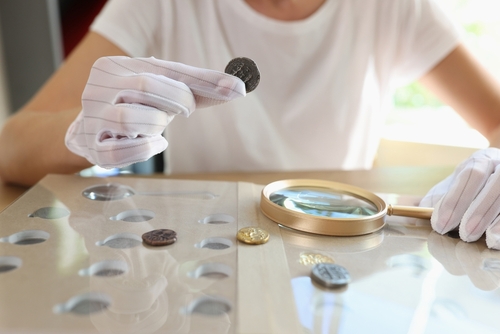
How to identify rare 50p coins in your collection
- Check the design: Look for rare 50p coin designs like the Kew Pagoda, the London Olympics set, the Beatrix Potter collection, or the 2023 low-mintage Atlantic salmon.
- Check the date: The year a coin was minted can affect its value. For example, a 2018 Peter Rabbit 50p can be much more valuable than a 2017 one.
- Check specifications: Since 1997, all 50p coins have a diameter of 27.3 mm, a thickness of 1.7 mm, and a weight of 8 grams. If your coin is a different size, it could be a fake, or it may have been damaged.
- Look for known errors: Even an ordinary coin can be valuable if there was a minting error. True errors like mis-strikes have crisp edges and repeatable features, unlike dents or wear from circulation.
- Grade the condition: The better condition the coin is in, the more valuable it could be.
- Research the value: The Royal Mint publishes mintage numbers to give you an idea of how rare a coin is. Sites like Change Checker allow you to compare rarity and get an idea of the potential value.
Keep an eye out especially for these collectible 50p coins:
- 2009 Kew Gardens
- 2023 Atlantic salmon (only 200,000 minted, the rarest 50p ever circulated)
- 2011 London Olympics, especially Judo, Wrestling, Triathlon, and Football
- 2017 Sir Isaac Newton
Where to sell your rare 50p coins
Finding a rare 50p coin is exciting, but its value only matters when you sell it. Here are the main selling options and what to consider for each:
- Auction houses such as Spink or London Coins specialise in the coin trade. They offer professional handling, expert promotion, and access to serious collectors. However, the commission fees can be quite high, at 10 to 20%.
- Online marketplaces like eBay are popular. You get a large audience, quick listings, and flexibility in setting reserve prices. However, there is a high risk of fraud and potential disputes on these platforms.
- Coin dealers make things easy by giving you expert valuation and immediate payment. However, they need to buy for less than what they sell for to make a profit, so they usually don’t offer the best prices.
Before you sell:
- Consider having your coin professionally appraised or authenticated, for example, through the Royal Mint. That way, you’ll know exactly what it’s worth, and you’ll be able to prove it to any potential seller.
- Timing matters. Commemorative coins or Olympic Games 50ps may fetch higher prices around anniversaries or related events.
Protecting and storing your valuable coins
A coin’s condition is just as important as its rarity. Even the rarest 50p coins lose value if they’re scratched, tarnished, or damaged. Proper storage and careful handling can preserve your collection for years to come.
Storage tips
- Store valuable coins in a cool, dry environment away from humidity, heat, or direct sunlight.
- Avoid PVC-based plastics, as these release chemicals that can damage coin surfaces over time.
- Use acid-free cardboard or hard plastic cases to keep coins airtight. For larger collections, consider specially designed coin storage boxes.
- Silica gel packs can help control moisture and prevent tarnishing.
Handling tips
- Handle coins only by the edges, avoiding contact with the faces.
- Natural oils from your fingers can stain or even corrode metal, so for very valuable coins, wear cotton gloves.
Insurance tips
- If you have a valuable coin collection, consider adding it to your home insurance policy.
- You may need to document and professionally value your coins, which can make any future claims easier if theft or damage occurs.
Treasures in your change
It’s exciting to think that a simple coin in your change could be worth far more than its face value. While rare 50p coins like the Kew Gardens or Atlantic Salmon may not make you rich, they can sell for hundreds of pounds, and even regular coins with minting errors can turn out to be hidden treasures.
Next time you get change, take a closer look at your 50p pieces. You never know what you might find. Spending one of these rare coins at face value could mean missing out on something truly valuable.
FAQs
How do I know if my 50p coin is genuine?
Check the weight, diameter, and thickness. A genuine 50p should measure 27.3 mm across and weigh 8 grams. Look for subtle differences in lettering, numbers, and design, as these can signal a fake.
What’s the difference between face value and collector value?
Face value is what the coin is legally worth. So, a 50p piece is worth £0.50. The collector value is what buyers are willing to pay based on rarity, condition, and demand. That’s why a 2009 Kew Gardens 50p collector value can be worth £200 or more.
Should I clean my rare 50p coins before selling them?
No. Cleaning can leave scratches and marks, which will reduce a coin’s value. Collectors prefer the original surface, even if it’s a little bit tarnished.
How much does it cost to get a coin professionally authenticated?
Professional grading can cost £20 to £50 per coin, with higher fees for higher value coins. Some dealers and auction houses offer basic valuation for free if you sell it through them.
Where can I find current market values for rare 50p coins?
Check collector platforms like Change Checker and auction houses like Spink. eBay can also give you a sense of what coins are going for, but the platform does suffer from a lot of fraudulent listings.
